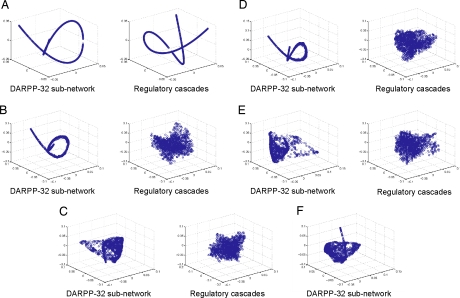Fig. 3.
Response manifolds for numerical simulations. (A) In the absence of perturbations, both the DARPP-32 subnetwork and the regulatory cascade follow (exactly) a simple one-parameter path, determined by the dopamine/glutamate ratio. The high-dimensional space curves are visualized in three dimensions by using Laplacian eigenmaps. (B) With modest perturbation, the response of the DARPP-32 subnetwork continues to follow a one-dimensional (but slightly noisy path). The regulatory cascades, however, no longer reflect a clear signal. (C) With sufficient noise (the large perturbation data set), the DARPP-32 response also loses its coherence, at least over some range of the dopamine/glutamate ratio. (D) Modified network 1 (see Fig. 4). cAMP is assumed to activate PP2A directly. Both PKA and PP2A are still activated in a coordinated fashion, and the DARPP-32 subnetwork clearly retains its coherence under modest perturbation. (E) Modified network 2 (see Fig. 4). All PP2A species are removed from the system (by setting their values to zero during the simulation). Clearly, the DARPP-32 subnetwork loses its coherence. (F) Modified network 3 (see Fig. 4). The regulatory cascades are eliminated by assuming that dopamine directly converts PKA to its active form (PKA-cAMP) and that glutamate directly converts PP2B to its active form (PP2B-Ca). As a result, the DARPP-32 subnetwork becomes much more sensitive to perturbations. That is, the removal of the regulatory cascades significantly affects the robustness of the signal transduction pathway.

